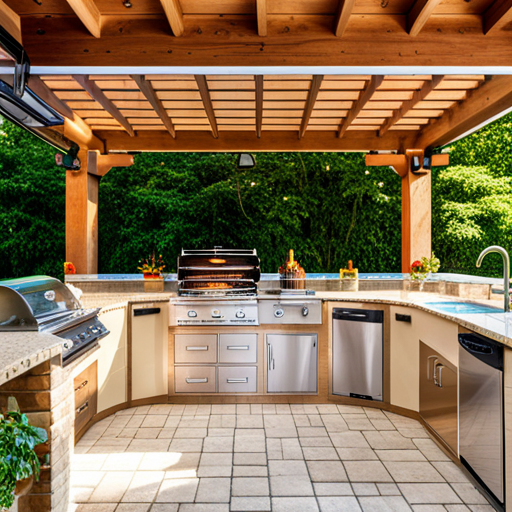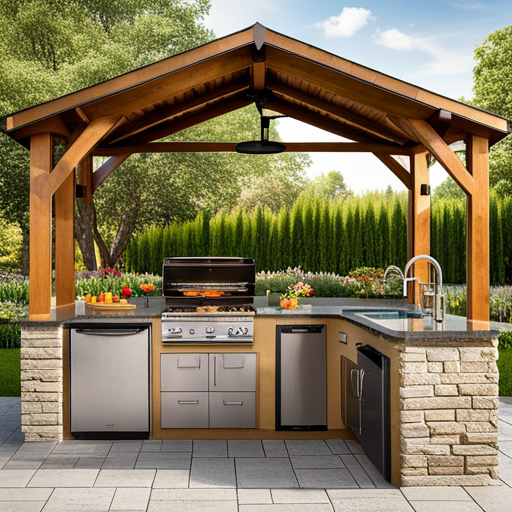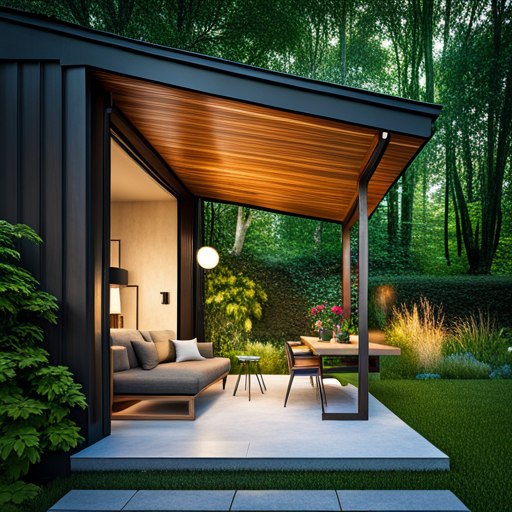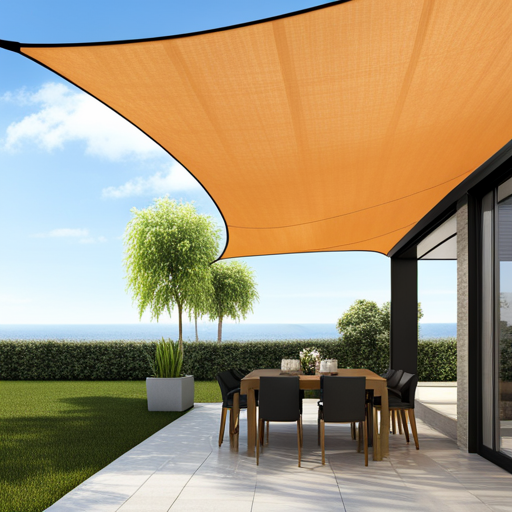Last Updated on June 19, 2024 by John Coleman
Whether you’re hosting a backyard BBQ or simply enjoying your morning coffee outdoors, large outdoor umbrellas provide essential sun protection while adding a stylish touch to your outdoor ambiance. There are over 30 million umbrellas sold per year in the U.S. alone. But how can you find the perfect one for you? Fret not! This comprehensive guide will take you on an exciting journey, unveiling insider tips and tricks to help you make the right choice. Prepare yourself for the ultimate adventure in seeking shade!
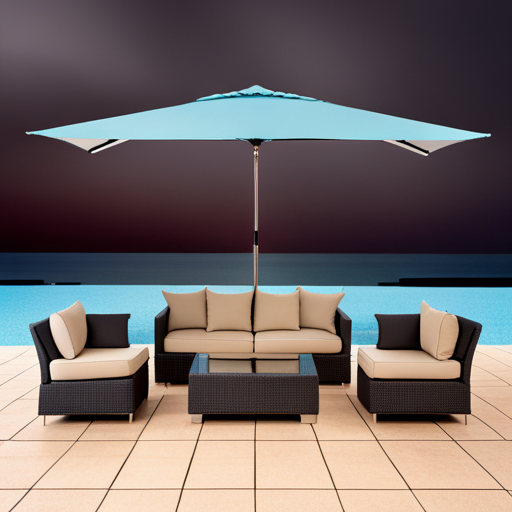
If you purchase through links on this site, we may earn a small commission. See our affiliate disclosure.
What is a Large Outdoor Umbrella?
Large outdoor umbrellas not only shield you and your guests from the sun’s harmful rays but also amp up the look of your outdoor area, giving it a chill and welcoming vibe. They can turn a sunny patio into a cool oasis, making even the hottest summer days a total breeze.
Types of Large Outdoor Umbrellas
Before you start shopping for a large outdoor umbrella, it’s important to understand the different types available. Here are the most common types:
Cantilever Umbrellas: Also known as offset or side-post umbrellas, these have a pole
located to the side instead of in the center, allowing for more flexibility in positioning. They are usually shaped as round, square, hexagonal, and octagonal. They are great for larger outdoor spaces and provide maximum shade coverage.
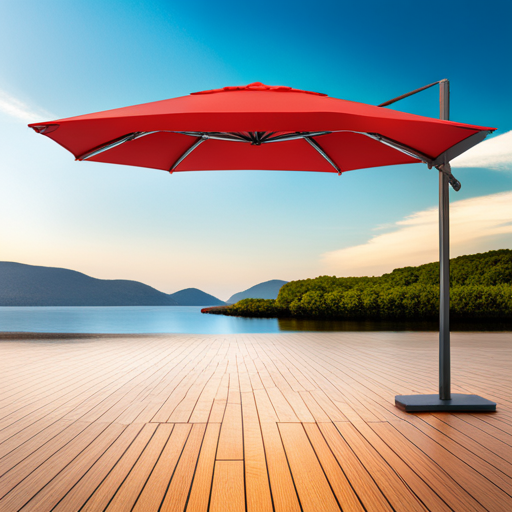
Pagoda Umbrellas: These are similar to cantilever umbrellas but with a distinct pagoda-shaped canopy. They add a touch of elegance and sophistication to any outdoor area.
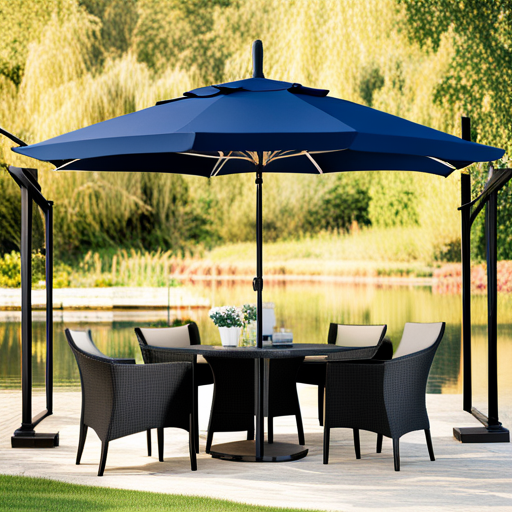
Market Umbrellas: This is the most common type of large outdoor umbrella. It has a center pole and can be either freestanding or used with a table. Market umbrellas are typically less expensive and come in a variety of sizes, shapes, and colors.
Materials Used for Large Outdoor Umbrellas
When it comes to materials used for outdoor umbrellas, there are a few options to choose from. Here are the most common materials and their benefits:
- Aluminum: This is a popular choice for umbrella frames as it is lightweight, durable, and rust-resistant. It is also easy to maintain and comes in a variety of finishes.
- Wood: For a more traditional look, wood frames are a great option. They are sturdy, provide good support, and can be stained or painted to match your outdoor decor.
- Fiberglass: This material is becoming increasingly popular for umbrella frames as it is lightweight, strong, and flexible. It is also resistant to rust, corrosion, and fading from the sun.
- Fabric: When it comes to the canopy of an umbrella, there are many fabric options available. Look for durable materials, water, and UV-resistant, and can withstand outdoor elements. Some popular choices include polyester, acrylic, and olefin.
- Thatch: Thatched umbrellas have a unique tropical look and are typically made from natural materials such as dried grass or palm leaves. They provide good shade coverage and can add a touch of exotic flair to your outdoor space.
Factors to Consider Before Buying an Outdoor Umbrella
Now that you know the different types of large outdoor umbrellas and what they are made of, here are some factors to consider before making a purchase:
What is My Budget?
Outdoor umbrellas come in various price ranges, so it’s important to consider your budget before buying one. Remember, pricier umbrellas often use durable materials and offer features like tilt mechanisms and UV protection. But don’t worry, there are also budget-friendly options that can still give you enough shade and style for your outdoor space.
What Size Umbrella Do I Need?
When choosing an umbrella, you want to make sure it fits your outdoor space and seating arrangements just right. A handy tip is to have the umbrella extend at least 2 feet on each side of your dining or seating area. For a 6-seater dining set, aim for an umbrella with a diameter of 9 feet or more. If you have a bigger group, think about going for a larger umbrella or even using multiple smaller ones.
What Type of Stand or Base Will I Need?
The stand or base of your umbrella is super important, just like the frame and canopy. It’s what keeps everything stable and supported. Depending on how big and heavy your umbrella is, you might need a heavier base to keep it from tipping over in strong winds. Look for stands that let you add weight, like sand or water, for extra stability. Oh, and remember that not all bases are one-size-fits-all. The weight of the base should match the size of the umbrella. A good rule of thumb is to have at least 10 lbs of base weight for every foot of umbrella diameter. Also, think about the design of the base so it goes well with your umbrella and the space you’re putting it in. You could even get an umbrella and base combo to make things easier. But if you’re buying them separately, I’d suggest getting the umbrella first and then finding the right base. If you are going to be moving the umbrella a lot, consider a base with wheels.
How to Match the Umbrella With My Outdoor Decor?
When picking an umbrella for your outdoor space, think about the overall vibe you want. Want to add a splash of color or pattern to jazz up a simple patio? Or do you prefer a laid-back, natural look? Look for umbrellas in different colors and designs that match your style and outdoor decor. You can also go for a neutral color that blends easily with any design scheme.
How Easy is the Umbrella to Set Up and Store?
Setting up some outdoor umbrellas can be a bit tricky, with lots of parts and confusing instructions. But if you’re gonna be moving or storing it often, go for ones that are easy to set up and store. Look out for features like a push-button tilt or a compact design for hassle-free storage.
Where Will Your Umbrella Be Located?
When choosing a spot for your umbrella, think about whether it’ll be in an open area or near a wall. This affects the type of base you’ll need for stability. Also, consider how much sun that area gets. If your umbrella will be in direct sunlight for long periods, go for models with UV-resistant fabric for maximum protection. You can even get a tilting or rotating umbrella to adjust the shade as the sun moves throughout the day.
Do You Need An Umbrella With Wind Resistance?
If you often experience strong winds in your area, consider getting an umbrella with wind-resistant features like a vented canopy or flexible fiberglass ribs. These features can help keep your umbrella from flipping or breaking when a strong gust of wind hits.
How Durable Is It?
Outdoor umbrellas have to face all kinds of weather – sun, rain, and wind. So, you’ll want materials that can handle it all. Look for options like aluminum frames and polyester fabric. They’re super durable and won’t rust or fade easily.
Will You Need Tilt Functionality?
Some umbrellas can tilt the canopy to provide shade at different angles. This can be useful for blocking out the sun at different times of the day.
Is the Umbrella Easy to Use?
Consider how easy it is to open, close, and adjust the umbrella. You want a mechanism that is user-friendly and doesn’t require a lot of effort.
Additional Features to Consider
- Crank lift mechanism for smooth and easy opening/closing.
- LED lights are built into the canopy for evening use.
- Built-in speakers for outdoor entertainment.
- Double-layered canopies for extra shade and protection.
- Removable fabric covers for easy cleaning.
- Customizable options such as color, fabric type, and size.
- Additional attachments such as mosquito netting or side panels for added comfort and privacy.
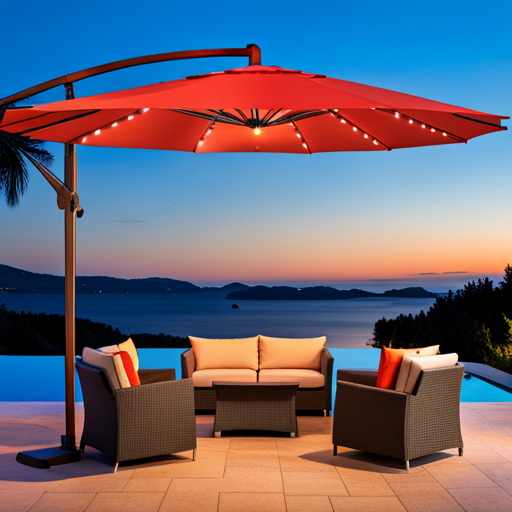
Does It Have a Warranty and Maintenance Options?
Before you buy an umbrella, think about the warranty and maintenance options. Some brands have longer warranties, while others provide comprehensive maintenance plans for any damage. Make sure you read the fine print and understand what’s covered under the warranty for long-lasting use of your outdoor umbrella.
How to Clean an Outdoor Umbrella?
Cleaning your outdoor umbrella regularly can keep it looking fresh and vibrant. Start by dusting off any loose dirt. For fabric canopies, use a mild detergent and warm water solution. Rinse thoroughly and let it air dry. For metal frames, use a non-abrasive cleaner and wipe down with a clean cloth.
Additional Tips for Outdoor Umbrella Care
Get a protective cover: Consider getting a cover designed for your umbrella. It’ll keep it clean and shield it from any potential damage when you’re not using it. Covers & All is a great site to shop for umbrella covers. They can make custom covers that fit to your specific umbrella.
Avoid leaving it open in strong winds: A sturdy umbrella can withstand some wind, but it’s best not to leave it open in very strong winds. If you know a storm is coming, make sure to close and secure your umbrella to prevent any potential damage.
Consider investing in a high-quality umbrella: While it may be tempting to go for the cheapest option, investing in a high-quality umbrella can save you money in the long run. A well-made umbrella will last longer and require less maintenance.
Regularly clean the frame: Don’t just focus on cleaning the fabric of your umbrella, make sure to also regularly clean the frame. This will help prevent any build-up of dirt or debris that could potentially damage it over time.
Store it properly during the off-season: When the weather starts to cool down or if you know you won’t be using your umbrella for an extended period, make sure to store it properly. This means taking any necessary precautions such as covering it and storing it in a dry and protected area to prevent any damage.
Whether you’ve got a big patio umbrella or a smaller one for your balcony, making sure you take good care of it will guarantee it lasts for many seasons. Oh, and don’t forget to regularly check and tighten any screws or joints to keep your umbrella stable and in tip-top condition. With the right maintenance, you can enjoy a beautiful and functional outdoor space all year round!
Styling Ideas for Outdoor Spaces With a Large Outdoor Umbrella
Outdoor umbrellas can totally steal the show in your decor! Play around with vibrant colors for a fun, summery vibe, or go for neutral tones if you want a more sophisticated look. You can even pair them with matching cushions or outdoor rugs for a super put-together style. And don’t be afraid to mix and match different patterns and colors to add that playful yet chic feel!
When choosing an umbrella, think about the style of your outdoor space. If you’re going for a modern look, a sleek and minimalist design would be perfect. But if your setting is more traditional, a classic umbrella with elegant details like fringes or tassels will do the trick.
Now here’s where you can get really creative – try angling or placing the umbrella off to the side for a unique touch. And if you want to create some cozy vibes, accessorize with string lights or hanging lanterns. You can even attach planters to the umbrella pole for some greenery!
Don’t limit yourself to just one umbrella. Get different sizes and types to cover different areas and weather conditions. Having options not only adds to the visual appeal but also gives you more flexibility for shade and shelter. So go ahead and have some fun with it!
Conclusion
Investing in a large outdoor umbrella is an excellent way to make the most of your outdoor space during the warmer months. With the right choice, you can stay cool, protect yourself from the sun, and elevate your outdoor décor. If you found this guide helpful, please feel free to like and share it with others looking to enhance their outdoor spaces.
Frequently Asked Questions
Can I use my outdoor umbrella in the rain?
Most outdoor umbrellas are designed to withstand light to moderate rain. However, it’s best to close them in heavy rain to prevent damage.
How can I prevent my outdoor umbrella from tipping over?
Using the correct base weight and closing your umbrella in high winds can help prevent it from tipping over.
How often should I replace my outdoor umbrella?
With proper care, most outdoor umbrellas can last several years before needing replacement. However, if you notice significant wear and tear or damage, it’s best to replace it for safety reasons.
Can I leave my outdoor umbrella outside all year round?
t’s recommended to store your umbrella in a covered area during winter months or when not in use for an extended period. This will help prolong its lifespan and prevent damage from harsh weather conditions. However, if you live in a mild climate, leaving it outside may be feasible.
See Also:
Cool Down Your Patio: A Guide to Choose the Best Shade Sail for a Patio
A Guide to Design a Low-Budget DIY Outdoor Kitchen
If you purchase through links on this site, we may earn a small commission. See our affiliate disclosure.


